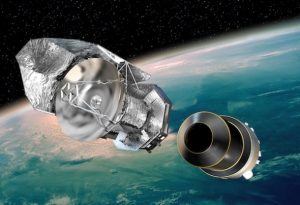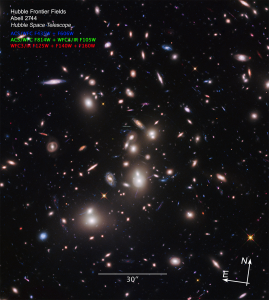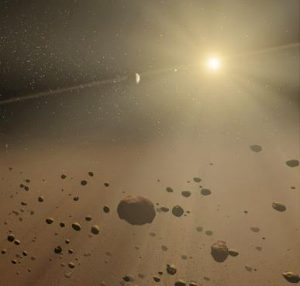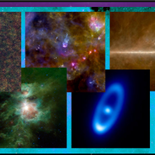Research Projects
Joining the Group
Students interested in research opportunities should contact Prof. Asantha Cooray at acooray@uci.edu.
As of June 2025, the group is at full capacity for undergraduate researchers, but we are still welcoming inquiries from prospective graduate students and postbaccalaureate researchers.
We especially encourage applications from students with backgrounds in computer science, machine learning, astrophysics, or engineering.
SPHEREx
The Spectro-Photometer for the History of the Universe, Epoch of Reionization, and Ices Explorer (SPHEREx) mission, launched in March 2025, will conduct the first all-sky spectral survey in near-infrared light, providing unprecedented insight into the large-scale structure of the universe and the physical processes that have shaped its evolution. By collecting over a billion spectra, SPHEREx will probe the earliest moments after the Big Bang, trace the evolution of galaxies and stars, and map cosmic ices—key components for planetary systems and the origins of life. These observations will provide transformative insights into the history of the cosmos and the conditions for habitability across the Milky Way. Our research focuses on the Extragalactic Background Light (EBL) component of the SPHEREx mission. We develop and apply advanced tools for precision photometry, quasar detection, and spectral analysis to disentangle faint extragalactic signals and understand the contributions of distant galaxies to the EBL. In collaboration with the broader SPHEREx team, we aim to refine techniques that reveal the structure of the cosmic web, characterize the evolution of luminous sources, and provide new constraints on fundamental processes driving the growth of the universe.
For more information, please visit: spherex.caltech.edu

Euclid
The Euclid mission, launched by the European Space Agency in 2023, is designed to map the geometry of the dark universe by observing billions of galaxies out to redshift ~2, covering over one-third of the sky. By combining high-resolution visible imaging with near-infrared photometry and spectroscopy, Euclid will enable precise measurements of dark energy, dark matter, and cosmic structure growth over cosmic time. Our group focuses on leveraging machine learning techniques to identify and classify sources of strong gravitational lensing within Euclid’s deep field data. These rare lensing events offer powerful tools for probing galaxy mass distributions, dark matter substructure, and the expansion history of the universe. We are developing automated pipelines to extract lens candidates, model their properties, and integrate them into cosmological analyses that enhance the scientific return of the Euclid mission.

MISE
The Mid-Infrared Sky Explorer (MISE) is a proposed NASA mission concept designed to conduct a full-sky spectro-imaging survey in the mid-infrared. By targeting key spectral features of interstellar dust and organic molecules, MISE aims to advance our understanding of the interstellar medium in the Milky Way and nearby galaxies. The mission will address the broader NASA science question: “How did we get here?” by characterizing mid-IR emission associated with complex dust environments, carbon and silicate extinction, and galaxy evolution across diverse environments.

Previous Projects
The projects listed below represent past research efforts that are no longer an active focus of the group. However, data, tools, and insights from these projects continue to inform and support aspects of our ongoing research.
CIBER
CIBER (The Cosmic Infrared Background Experiment) is a sounding rocket payload designed to characterize the near infrared (IR) background light. CIBER is built by an international collaboration of Universities and Government Laboratories which has flown twice and, having acquired a data set which is not possible from other platforms, will soon shed new light on the nature of the Cosmos.
What is the Infrared Background?
The Extragalactic Infrared Background (EBL) is the integrated light from all of the infrared sources in the Universe. In the near IR, these photons are produced by stars are a by-product of nucleosynthesis. Measurement of the near IR EBL therefore a constrains the stellar content of the Universe. Learn More
Through a variety of investigations, the Far-IR Surveyor will address one of the most compelling questions imaginable: How did we get here? That is, “How did our galaxy form?,” and “How did our life-bearing planet form?” The Far-IR Surveyor mission will revolutionize our understanding of planetary system formation, detect previously unknown extrasolar planets based on their sculpting effects on protoplanetary and debris disks, unveil the dark side of galaxy evolution, and open up an information-rich and still largely unexplored region of discovery space. The quest to understand water transport in protoplanetary disks and the formation of a planet like Earth is a particularly compelling mission goal. Similarly tantalizing, many distant galaxies emit most of their light in the far-IR and are too deeply shrouded in dust to discern whether they are powered predominantly by young stars or nuclear activity.
These and other visionary science goals and measurement requirements for the Far-IR Surveyor will be established by a community-based Science and Technology Definition Team (STDT). Learn More
HERSCHEL
The Herschel Space Observatory’s mission has been designed to unveil a face of the early Universe that has remained hidden until now. Thanks to its ability to detect radiation at far infrared and sub-millimetre wavelengths, Herschel will be able to observe dust obscured and cold objects that are invisible to other telescopes.
Herschel’s major objective will be discovering how the first galaxies formed and how they evolved to give rise to present day galaxies like our own. Additional targets for Herschel will include clouds of gas and dust where new stars are being born, disks out of which planets may form and cometary atmospheres packed with complex organic molecules.
The Herschel Space Observatory is a space-based telescope that will study the Universe by the light of the far-infrared and submillimeter portions of the spectrum. Learn More
CANDELS
CANDELS is the largest project in the history of Hubble, with 902 assigned orbits of observing time. This is the equivalent of four months of Hubble time if executed consecutively, but in practice, CANDELS will take three years to complete (2010-2013).
The core of CANDELS is the revolutionary near-infrared WFC3 camera, installed on Hubble in May 2009. WFC3 is sensitive to longer, redder wavelengths, which permits it to follow the stretching of lightwaves caused by the expanding Universe. This enables CANDELS to detect and measure objects much farther out in space and nearer to the Big Bang than before. CANDELS also uses the visible-light ACS camera, and together the two cameras give unprecedented panchromatic coverage of galaxies from optical wavelengths to the near-IR.
CANDELS will exploit this new lookback power to construct a “cosmic movie” of galaxy evolution that follows the life histories of galaxies from infancy to the present time. This work will cap Hubble’s revolutionary series of discoveries on cosmic evolution and bequeath a legacy of precious data to future generations of astronomers.
CANDELS will also test the reality of cosmic dark energy by measuring the brightness of a special class of exploding supernovae called Type Ia. By spotting these objects out to farther distances, CANDELS will establish whether these objects are in fact precision “standard candles” for probing the geometry of spacetime. Learn More
ZEBRA
Our group is a founding member of the ZEBRA instrument. An instrument for astrophysical measurements related to diffuse backgrounds from 5 to 10 AU was proposed in the Astro2010 White Paper by Cooray etc.
The ZEBRA science team brings together experts from astrophysical disciplines as diverse as reionization, the star-formation history of the Universe, exoplanet detection and characterization, Zodiacal dust and outer solar system bodies, and astronomical instrumentation.
Scattered sunlight from dust in the inner solar system is bright, presenting the dominant foreground for measurements of the extragalactic background light and obscuring our view of the structure of dust in the outer solar system.
The Zodiacal sky brightness at Jupiter (5 AU) and Saturn (10 AU) is 100 – 1000 times fainter than at Earth (AU) [light blue curves]. This large reduction in the dominant foreground allows definitive measurements of the Extragalactic Background Light (EBL) [red curve].
